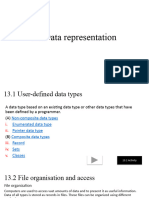0% found this document useful (0 votes)
21 views2 pagesData Representation
This chapter covers user-defined data types (UDTs), including their definitions, types (non-composite and composite), and strategies for designing them. It also discusses file organization and access methods, hashing algorithms, binary floating-point numbers, and conversion between binary and denary formats. Additionally, the chapter addresses normalization, underflow, overflow, and rounding errors in binary representation.
Uploaded by
shola shodeindeCopyright
© © All Rights Reserved
We take content rights seriously. If you suspect this is your content, claim it here.
Available Formats
Download as DOCX, PDF, TXT or read online on Scribd
0% found this document useful (0 votes)
21 views2 pagesData Representation
This chapter covers user-defined data types (UDTs), including their definitions, types (non-composite and composite), and strategies for designing them. It also discusses file organization and access methods, hashing algorithms, binary floating-point numbers, and conversion between binary and denary formats. Additionally, the chapter addresses normalization, underflow, overflow, and rounding errors in binary representation.
Uploaded by
shola shodeindeCopyright
© © All Rights Reserved
We take content rights seriously. If you suspect this is your content, claim it here.
Available Formats
Download as DOCX, PDF, TXT or read online on Scribd
/ 2

























































